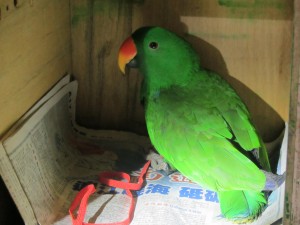This week was our first week at the SPCA. We were paired up with inspectors, who go out on a daily basis answering to emergency rescue calls. The hotline gets information about various animals in need. On our first day, we rescued a cat from a wet market (fresh meat and produce markets) where it had been in one of the stores for four days without food or water. We also rescued an exotic bird, a dog that had been hit by a car and two more cats that had found themselves in sticky situations.
What we’ve gathered from our very brief experience with the inspectors so far is that there are some fascinating differences between Canada and Hong Kong when it comes to animals and people. Many of the animals that we would think of in Canada as pets, especially the street dogs, are often as afraid of the people as the people are of them. This makes the work of helping them when they are sick or injured that much more difficult. While walking to the SPCA on Monday we tried to give a street dog some water, which it clearly needed, but its fear overwhelmed its need to drink and it ran away. Perhaps the difference lies in part in the fact that Canada doesn’t have such a visible stray animal problem, which is not to say it doesn’t have a problem – just that it’s not as visible. But it’s also true that in Hong Kong different dogs are socialized to have different relationships with humans. There are the true pets who are very used to humans, the community or loosely owned dogs who are often a bit more circumspect and the truly feral dogs who won’t come near humans voluntarily (http://www.spca.org.hk/en/animal-birth-control/community-dog-programme). The category we don’t tend to have in Canada are the loosely owned or community dogs.
Despite the different categories of dogs, some things are the same. Today we went to try to capture a semi-feral, feral or perhaps even loosely owned dog – it’s not always easy to tell the difference – that has an enormous tumour protruding out of its stomach. If and when this dog is caught it will likely be euthanized a: because it is suffering and b: because it will need surgery and medication and the costs would be prohibitive for an animal that even if it survived, would likely not be adoptable. The same welfare based approach would probably happen in Canada. What compounds this dog’s circumstances in Hong Kong, however, is not only its status but its size. Given the space restrictions in Hong Kong, the public is a lot less likely to adopt a large dog to begin with, let alone one that might need considerable medical care. While the idea of euthanizing an animal simply because it needs expensive medical attention raises complex moral questions the same dilemma emerges in Canada on a daily basis. Such intensive veterinary care is often prohibitively expensive and many simply cannot afford it. This economic barrier to good welfare pushes people towards abandonment, surrender to shelters or euthanasia.
But it is also true that in Canada the overall culture, including economics, surrounding companion animals has shifted considerably around veterinary care and people are increasingly encouraged to go to extreme lengths to provide their pets with medical intervention at all costs – literally! Surgeries running to the thousands of dollars are not unusual. But this raises the question of the relationship between class/economics and welfare. It’s only those people with money who can genuinely afford to provide this kind of care for their animals and this is as true in Hong Kong as it is in Canada. For those who don’t have access to the same financial resources the options are fewer – go into debt to pay the bill, abandon, or surrender the animal. Against this backdrop then, prolonging the life of an animal like the one with the tumour, seems like a poor use of very limited resources. For a street dog, there are few options.
In conclusion, there are interesting similarities as well as differences emerging especially around the challenge and management of unwanted animals. In both countries, paradoxically, euthanasia is often the option that is seen to be in the best interests of the animal; this is the animal welfare focused option.Yet ‘welfare’ is clearly inseparable from economics.
Krista and Ryanne


